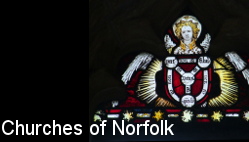
home I index I latest I glossary I introductions I e-mail I about this site
St Margaret, Drayton
Follow these journeys as they happen at Last Of England Twitter.
| St
Margaret, Drayton For a city
with such a remarkably interesting centre, the suburbs of
Norwich are surprisingly dull. As Pevsner observed, there
is a paucity of worthwhile buildings except in a few
places. Go a bit further out however, and those
skeins which float free have at their hearts what were
once villages, and although the centre of Drayton can be
a traffic nightmare the former village is discernible,
and at its centre is this church. It is not a large
building, set close above a short lane that runs beside
the former village green, now a children's play area. The
churchyard opens out towards the west. The exterior of
the church is so crisp and neat that you won't be
surprised to learn that the church was rebuilt on its
original plan in the mid-19th Century, with the addition
of a wide north aisle. The tower came first after
collapsing in 1850, and then the nave and aisle. The
chancel was rebuilt last of all in 1866, by which time
there was more of an interest in preserving the past, as
we will see inside. The 15th Century south porch was
retained, and externally at least it is the only old
thing here, although it is pleasing that the nave roof is
still thatched. The window on the south side of the nave on the other side of the chancel arch contains a delight, two panels of 16th Century German glass. One depicts the aged Anna leaning on her stick at the Presentation in the Temple, while the other is a tender Visitation scene, Mary meeting her cousin Elizabeth in the hill country when they are both pregnant for the first time. Birkin Haward notes that they were installed here in the 1960s by King & Son of Norwich. Interestingly, the window sill beneath this window has a piscina drain set into it, showing that there was once an altar here. The east end of the north aisle forms a little chapel, and the glass in the north corner is etched with a tall depiction of the Blessed Virgin and Christ child. The other glass in this aisle is from the 1880s, and which at first sight appears to all be by Clayton & Bell, although Birkin Haward points out that the glass depicting the Crucifixion and Resurrection was by J&J King of Norwich. From a few decades later comes a brass which notes, unusually, that the person remembered by it died from effects of poison gas. Up in the chancel, the 14th Century piscina was reset from the old church, a mark of how antiquarianism had taken a hold by 1866. The east window contains inoffensive early glass of the Ascension by Ward & Hughes before Thomas Curtis carried the company on a descent into mawkishness. The old chancel was still in situ when Thomas Blofeld, rector of Drayton, filled in the return for the 1851 Census of Religious Worship. One hundred and seventeen of Drayton's four hundred and seventy two parishioners attended the afternoon sermon that day, a high proportion for this part of Norfolk, although thirty nine of these were Sunday scholars who had no choice but to be there. The church had seating for one hundred and forty people, only eighty of which sittings were free. It must have been a tight fit, and Blofeld's energy and enthusiasm would see the church rebuilt soon after. Simon Knott, March 2023 Follow these journeys as they happen at Last Of England Twitter. |
|
|||||||||||||||||||||||||||||||||||||||||||||||||||||||
home I index I latest I introductions I e-mail I about this site I glossary
links I small
print I www.simonknott.co.uk I www.suffolkchurches.co.uk
ruined churches I desktop backgrounds I round tower churches